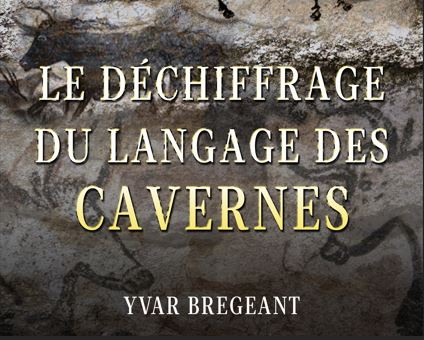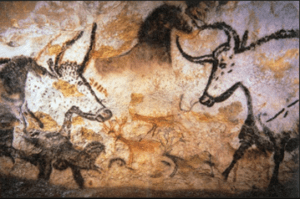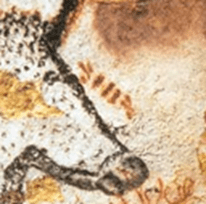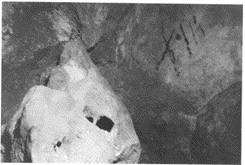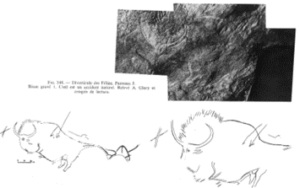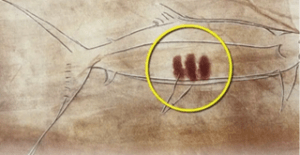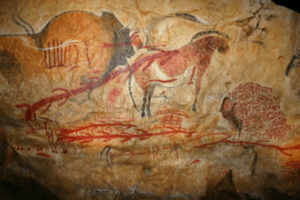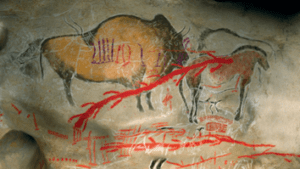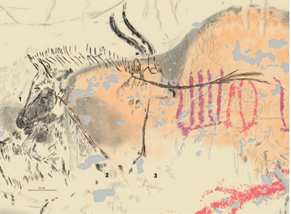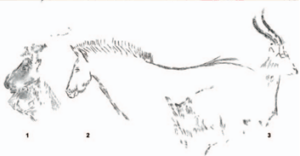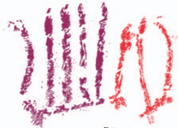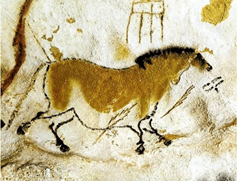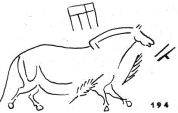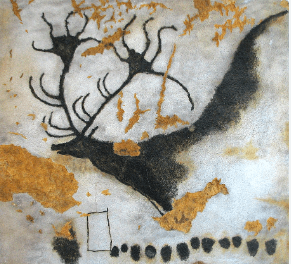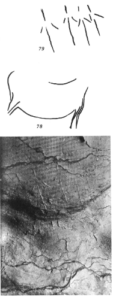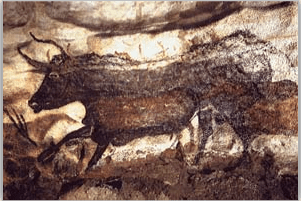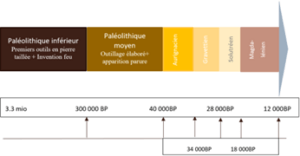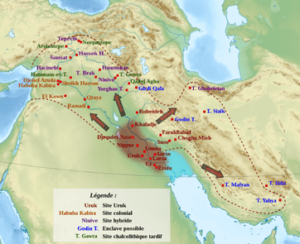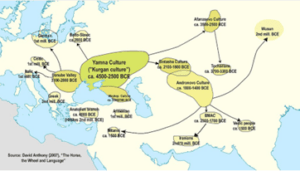PURPOSE OF THIS ARTICLE
This article is the introduction to the book entitled “Deciphering the language of the caves. It is divided into three parts. The first part of the book cites the example of the cave paintings in the Lascaux cave, which are analysed and deciphered in the book. The second part sets out how the book is structured. The third part lists the classic argument used to deny the possibility of a cultural and linguistic link between prehistory and history: the gulf of time that separates them, an argument that is later refuted by the facts.
Table of contents
LINK THIS ARTICLE TO THE ENTIRE LITERARY SERIES “THE TRUE HISTORY OF MANKIND’S RELIGIONS”.
This article is an excerpt from the book also available on this site:
Volume 2 Book 2 Deciphering the language of the caves
You can also find this book here :
Already published books
To find out why this book is part of the literary series The True Stories of Mankind’s Religions, go to page :
Introduction / Structure and Content
I hope you enjoy reading this article, which is available in its entirety below:
Deciphering the language of the caves: an introduction
EXAMPLE OF THE LASCAUX SITE
To begin our analysis of the oldest known prehistoric mythology, I find it particularly useful to start with an example that’s likely to speak to everyone: the Lascaux cave.
I invite you to visit our website:
https://archeologie.culture.gouv.fr/lascaux/fr/visiter-grotte-lascaux where you can take a virtual tour of this emblematic site.
You’ll see that this “mythical” (!) cave is divided into several phases:
- The entrance to the cave in the Hall of Bulls, with the unicorn panel on the left.
- The axial diverticulum and its two ornate walls
- Le Passage
- The Nave and its two walls
- The Cat Diverticulum
- Figures from the depths
- The apse
- The well
The Unicorn panel:
This panel is remarkable because the very fact that the first animal encountered is a mythological one, a unicorn, suggests that we are dealing here with a mythological representation.
We can see that the unicorn seems to be pushing a herd of smaller horses towards the interior of the cave, towards the axial diverticulum below, located between the two bulls and thus towards the cave’s purpose, the apse and the well.
This first panel features two massive bulls, one with five small deer associated with it, and the other with a red cow associated with it. Both bulls face the entrance to the axial diverticulum, as if to indicate the path to the cave floor.
WHAT’S A BRIEF EXPLANATION OF LASCAUX?
Once you’ve reviewed these few elements of the site, what explanation can we give?
It is essential to understand that the deciphering of mythological symbolic language that will be developed in future books will enable us to fully understand the meaning of Lascaux and its many representations, as indeed of all prehistoric sites.
In fact, Lascaux, like many other megalithic sites, is a perfect illustration and expression of the same mysticism that underlies them all.
Deciphering summary
To decipher Lascaux, I could start by saying that it’s a temple, a sanctuary.
From this point of view, please note that I don’t differ from the majority of specialists who agree that this cave is a real sanctuary, a sort of religious monument, starting with A. Leroi-Gourhan.[1]
From this point of view, I take issue with the various theories disconnected from the reality of this place (sky observation center for Chantal Jègues-Wolkiewiez[2] , physiological fertility theory for Thérèse Guiot-Houdart[3] , “usual” shamanic theory for Jean Clottes and David Lewis Williams[4] , fear of image animation for Julien d’Huy and Jean-Loïc Le Quellec ). [5]
On the other hand, I could go further than my predecessors in asserting that this is a temple, a sanctuary, starting from the symbolism of the mountain and the cave, in order to demonstrate to you that in the original universal mythological symbolic thought, the mountain represents the body of the mother goddess and the cave, her womb.
I could then show you that the great male animal representations in this cave – bulls, deer, bears, etc. – are avatars of the great male divinity, the primordial father turned father of the gods, just as the great female animal representations – the unicorn, cows, mares – are avatars of the primordial mother, deified mother-goddess.
I could tell you that both are represented here to serve as guiding deities for the entrants, the living and the dead, the flock of their children, descendants and worshippers, represented by the smaller animal figures, to follow the path that both show them, to the bottom of the cave, to the well that symbolizes their death, their entry into the bowels of the womb, to undergo the same punishment as the primordial father (the primordial progenitor in the ithyphallic position, the wounded, acephalic man, condemned to death, symbolically decapitated), and then, like him, thanks to the purifying and regenerating power of the mother goddess’s womb, to be reborn after their death purified, like divinities, stars, in the light of a new day.
I could tell you all that, but, no, I won’t.
Damn.
I’ve just reread myself and realized that I told you anyway.
Yes, but well…let’s just say that since I haven’t demonstrated it to you, it doesn’t count.
Yes, it’s a bit hard to forget, so…
What am I supposed to do now?
Do I have to prove it to you?
To find out, let’s ask ourselves the right question: does it make sense to explain and demonstrate all the mysticism of archaic mythology to you, starting with a single example that illustrates it, however emblematic it may be, such as Lascaux?
Actually, no.
Because an example supports the overall demonstration, and not the other way around.
It’s much better if I start at the beginning, from the origin of the events that gave rise to all the sacred mysticism of Mythology, after which the hidden meaning of all the sacred sites will become clear to you.
I’ll be giving priority to the progressive development of this mysticism, after which we’ll analyze in detail the various examples that illustrate it, notably in Volume 6, dedicated to the analysis of megalithic sites. In fact, this volume will begin with an analysis of the “prehistoric cave”.
So why am I talking about it here?
As I’ve already said, this is to prove to you that sumerian and, to a lesser degree, egyptian hieroglyphics are the timeless keystone of universal mythological language.
So please allow me to demonstrate that animal figures and their associated signs can be deciphered using these languages.
To do this, let me show you a few examples of rock carvings with signs, after which we’ll decipher them one by one.
Rock art signs
In this brief chapter, I’m going to give you a few examples of these signs, which we don’t usually pay much attention to, focused as we are on animal figures, but which are just as common in painted caves.
First of all, I’m going to show you some of the signs that can be found at Lascaux, as well as a few examples from other caves.
Here are the images[6] :
Examples of a dozen rock art signs
Lascaux cave: The first bull on the Unicorn panel
https://fr.wikipedia.org/wiki/Grotte_de_Lascaux#/media/Fichier:Lascaux_painting.jpg
In the image of the unicorn panel, there’s a sign opposite the first bull.
Here it is enlarged:
https://fr.wikipedia.org/wiki/Grotte_de_Lascaux#/media/Fichier:Lascaux_painting.jpg
Note that there are three successive sticks: III
These three sticks can be found at the end of the site at the well.
Lascaux cave: Sign XIII of the feline diverticulum shaft
For example, at[7] : “In the last two-thirds of the Feline diverticulum, the number of schematic and animal figures is much lower than in the vestibular part. Among these, we note an association of two juxtaposed geometric shapes, one in the form of a cross, the other made up of three parallel lines. Side by side, these two entities form the Roman numeral XIII. They are painted black.
It’s important to understand that this XIII sign is the fusion of the X cross and III, hence the repetition of this sign.
Here’s an image taken from an analysis by André Leroi-Gourhan, one of the eminent archaeologists whose work we’ll be quoting from later on[8] :
Fig. 347. – Feline diverticulum. Panel I. The “XIII”. Diagonal cross and triple parallel line, painted in black at the bottom of a niche on the west wall. Note then that the X cross, dissociated from the III and associated with a bison, can be found on panel J of the feline diverticulum, i.e. on the panel next to the one containing the XIII sign.
Fig. 348 – Feline diverticulum. Panel J Engraved Bison. 1. The eye is a natural accident. Sketch by A. Glory and reading sketch
Pindal Cave: Salmon sign III
This figure is apparently one of the examples used by Mr. Ben Bacon to support his very recent thesis that the stroke and dot signs are proto-writings indicating the lunar mating months of the figurative species associated with these signs.
This image of a salmon, engraved 17,000 years ago in the Pindal cave in Asturias (Spain), features three lines placed inside. | M. Berenguer/Durham University
https://trustmyscience.com/decouverte-plus-ancienne-proto-ecriture-peinture-art-rupestre/
Marsoulas cave: the large panel fresco
Equally interesting is the Marsoulas fresco (we’re leaving Lascaux for a moment):
http://prehistoart.canalblog.com/archives/2009/11/01/15639490.html
or with this other image:
Marsoulas. The Large Painted Panel, 15,000 years ago… Hypothesis for the restitution of the left flap. 3D image from M. Azéma’s film “Marsoulas, la grotte oubliée”.
This representation is also partially and schematically represented in André Leroi-Gourhan’s essay[9] :
If we examine the fresco more closely[10] , there are in fact three other intertwined animals in addition to the large central bison: another bison, an ibex and a horse.
Large painted panel. Engraved ibex with black horns (no. 3), engraved horse (no. 2) and young black and engraved bison (no. 1), whose heads are intertwined. Precise outlines can only be isolated by selective surveying. © C. Fritz and G. Tosello.
The sign of two parallel horns
The way in which the fresco is depicted, with the ibex erased and only its horns in evidence, clearly serves to highlight 

The “spade” sign
Even if there are other very interesting signs on this fresco, I draw your attention to those represented on the bison’s flank, particularly the first one:
Large painted panel. Detail of the series of inverted-T signs painted in purple and red on the large buffalo. The two signs on the right have been misinterpreted as a claviform. © C. Fritz and G. Tosello
https://www.creap.fr/pdfs/CFGT-Marsoulas-DARCH2007.pdf ; p.26
Marsoulas cave: The second beech-shaped sign
André Leroi-Gourhan also found a sign from the Marsoulas cave in his references (200 and 198).[11]
Note that this sign is different from the one already observed
since its left tooth is straight while that of the second is curved.
Lascaux cave: the second Chinese horse
Another example of a sign is the one associated with the horse known as the second Chinese horse, which can be found on the right wall of the axial diverticulum.
Crotos website: Wikimedia Commons
This painting was also taken up by André Leroi-Gourhan in his essay as follows (in the form of a survey):
In addition to the two branching forms, we find the quadrangular sign and the sign
(cited as an example by André Leroi-Gourhan in reference no. 147).
Lascaux cave: The black stag fresco
Another example of a sign is that associated with the black deer, which is located on the right wall of the axial diverticulum:
Crotos website: Wikimedia Commons
It is this sign that André Leroi-Gourhan cited in an essay[12] in the following way (in the form of a survey) among other signs:
Lascaux cave: the sign of four arrows of the acephalous horse
We also find[13] the following sign associated with an acephalous horse in the feline diverticulum:
André Leroi-Gourhan has taken up this figure in his essay[14] :
Lascaux cave: The sign of the Great Black Bull
As another example, I’d like to draw your attention to the sign positioned under the muzzle of the big black bull in the left wall of the axial diverticulum.
Note above all what we say about this Bull: “With the Great Black Bull, we have access to the most emblematic work, not only of Lascaux, but of all Palaeolithic caves and painted shelters. Its dimensions – 3.71 m wide, 1.93 m high – make this representation of an aurochs a monumental work. This character is accentuated both by the very dark color of the coat, which contrasts with the immaculate background, and by the absence of figures that could graphically rival this subject. Within a radius of 5 m, in fact, no representations other than those aggregated – almost phagocytized – by the imposing silhouette, interfere with the surrounding space”.
Crotos website: Wikimedia Commons
Do you see the sign in question?
Here it is enlarged:
Conclusion
After I’ve shown you these signs, those of you who are new to them will certainly thank me for highlighting them, and those of you who are already familiar with them won’t be at all surprised.
But now let’s see what they mean…
Rock art Signs. Significance.
Structuring
Here’s how it works.
I’ll start by demonstrating that the rock frescoes correspond in every respect to an archaic ideographic script: proto-Sumerian.
This will be the first major step.
After this, I’ll move on to deciphering the frescoes we saw in the introduction.
I’d like to make it clear that the first, demonstrative part of the book is not as spectacular as the subsequent part on decoding, as it will necessarily be an academic demonstration, in order to prove to all readers – especially the most skeptical and demanding, including the archaeology community – that my assertion is extremely well-documented and factual.
I have no doubt that the second major part on the deciphering of the frescoes cited in the introduction will enthrall all readers because, once again, it is of a truly spectacular nature, but it seems necessary to me, in order to respect the coherence and progressiveness of the whole argument, to begin first with the academic demonstration.
The first major part of our work will therefore consist in demonstrating semiologically that the cave signs correspond to a “known” ideographic script, proto-Sumerian. “Known” is a figure of speech, in the sense of catalogued, as this is in fact a language known only to a handful of linguists of archaic languages, but, having said that, it’s a script that has the great merit of having already been deciphered. We’ll see what language we’re talking about later.
This demonstration will begin with a first chapter that will enable us to understand why it poses a serious problem for the scientific community to admit that an archaic ideographic script could be that of rock figures.
Then we’ll move on to the pure demonstration, which will take place in four stages:
First of all, I’d like to present you with a table comparing around a hundred identified prehistoric signs with other signs from this archaic ideographic language. Although you won’t be familiar with all of them, this visual comparison will enable you to appreciate their extreme similarity, and in itself attest to the fact that we’re dealing with the same writing system.
I’ll then look back at the various reference works carried out in the past by archaeologists specializing in this “mysterious” question of prehistoric signs, reviewing their findings (list of signs, various rules observed attesting to the fact that this is a semiological system) and their conclusions.
This analysis of their research will enable us to put our finger on the underlying reasons, the errors that led these specialists in prehistoric signs to never make the connection between these two scripts, even though, as we shall see, they had considered the ideographic path.
Then, together, we’ll do the comparative analysis that the referring archaeologists should have done, had they been linguists or had they been accompanied in their research by a linguist specializing in archaic languages: a precise comparative analysis between, on the one hand, the semiological system of cave signs with all the characteristics they have identified and, on the other hand, the archaic ideographic writing of reference.
This will demonstrate that the latter absolutely meets all the criteria they had observed.
At the same time, I’ll briefly review all the other archaic ideographic scripts that could also have been potential candidates, in order to demonstrate that they are far from meeting the same criteria as the reference archaic ideographic script alone.
Once this semiological demonstration is complete, we can move on to deciphering the frescoes.
This deciphering will be the practical, concrete proof that the writing I’m about to show you can indeed be used to decipher cave signs and understand not only their literal meaning, but also and above all their cultic, i.e. symbolic, religious, sacred meaning.
For this work of translation and deciphering, I’ll be relying heavily on the ideographic language of reference, proto-Sumerian, but also, occasionally, on certain closely related archaic languages (Egyptian hieroglyphic, hieroglyphic Hittite), for, Even if the latter do not meet all the identification criteria of the prehistoric fresco language, they can nevertheless, as we shall see, be a valuable source of information, not only to corroborate the meaning revealed by the reference ideographic script, but also, depending on their proximity to it, to shed light on certain signs.
Although I can continue to decipher beyond this dozen frescoes, I won’t go any further and will explain myself at the end of this book.
Logically, semiotic demonstration on the one hand, coupled with decoding on the other, should be more than enough to convince you and win your support.
But you may be wondering: why this structuring?
Wouldn’t starting with deciphering be the best and most direct way of demonstrating that I can decipher rock frescoes using identified ideographic writing?
Doesn’t starting with technical semiological considerations such as those to be made in the demonstrative section run the risk of losing many readers along the way?
In fact, it’s important to understand that this is an eminently serious subject, with far-reaching consequences, and anything that can provide a theoretical and definitive basis for the assertive nature of my remarks must be done to break down the all-but-natural resistance that will otherwise stand in the way of this understanding.
So, yes, deciphering would normally be enough for a logical, rational and objective mind.
But the scope of this discovery is such, and it calls so many things into question, that I feel it’s best to proceed in this progressive, academic, scientific way, so that the demonstration is unquestionable.
In fact, if I didn’t take such an approach, I can already hear the voices that would be sure to raise their voices, saying that this “theory” that “cave language corresponds to an archaic ideographic language” is not factual, and that all my explanations are just there to sensationalize.
In order to help all those who think this, but who are nonetheless reasonable people and likely to question themselves, it seems necessary to me to add, even before my deciphering of the prehistoric faith, the semiological demonstration.
I’m convinced that once any objective, rational person has read all this documentation, even the most perplexed will be convinced of the validity of my conclusions.
The only ones left on the sidelines, in my opinion, will be the dregs, the eternal cynical contemptuous usuals, the modern children of Diogenes of Sinope, the first of the cynical philosophers, who spent his days venting his venom on others in a systematic position of rejection (including fecal rejection) of everything and about everything.
Because the demonstration will be total and unequivocal, even if, as I’ve said, there are always a few errors to be found here and there, which some people will be sure to clumsily exploit to topple the whole edifice.
Unfortunately, I couldn’t do anything for them, because no matter how many proofs I accumulate, being neither rational nor humble, they won’t listen to reason, so I’m not interested in them.
But I mustn’t let a few screeching, black sheep make me lose sight of the need to “do the right thing” so as not to lose anyone who deserves it along the way.
That’s why, even if it’s only useful for one person, I do it this way.
So let’s now see why the scientific community has a serious problem admitting that archaic ideographic writing can correspond to the writing on rock carvings…
THE PROBLEM POSED BY THE ASSERTION THAT THE SUMERIAN IS THE UNIVERSAL KEY TO THE SYMBOLIC LANGUAGE OF THE FALSE ORIGINAL RELIGION
Yes, the fact is that I’ve told you that all my demonstrations in the books to come, all my deciphering of the symbolic language of mythology, have been based on Sumerian and its younger sister, the language of hieroglyphics.
I’ve also told you that deciphering the mysteries of the sacred science of Sumer and Egypt, which then spread to every continent, will enable us not only to understand the beliefs of the civilizations that followed them, but also to go back in time and understand those of the civilization(s) that preceded them, from the Neolithic and Paleolithic periods.
First of all, it is important to realize that asserting this point is a very daring position:
The corporatism of the archaeologists would refuse me
Why?
Because there’s no doubt that, even if I confront all the prehistoric specialists with the uniqueness of the symbolic language between that used in prehistoric times and that of Sumer and Egypt and, by extension, that of the entire ancient world, that it is universal and timeless, that this unique language transcends and crosses all known eras without having changed profoundly, having simply and quite logically undergone local adaptations, yes, even if I were to demonstrate this to them, the vast majority of them would still refuse to recognize and admit it.
Why?
Because, from their point of view, this would be comparing apples and pears, in the name of the temporal gulf which, according to them, separates the Palaeolithic from Sumer and Egypt, and which they estimate to be tens of thousands of years old according to their current dating methods.
As a result, it will be impossible for them to admit that there could be a link, an identical mythology, between these three great periods that seem so distant.
The time gap between the Upper Palaeolithic and Sumer
To understand just how wide this gulf in time is, from their point of view, it’s enough, for example, to visualize on a time-line the Palaeolithic and its various sub-periods, then the Neolithic, and also, therefore, the most archaic period known for the appearance of writing, the protohistoric civilization of Sumer, identified as the archaic period of Uruk, the first city where we find the first ideograms, ancestors of cuneiform writing: proto-cuneiform.
Prehistoric timeline
Here is a comparative frieze of the major periods:
Palaeolithic time line
If we now focus on the Palaeolithic period, we obtain[15] :
Where do some of the best-known caves fit into this graph?
The Chauvet cave has been dated from the Aurignacian to the Solutrean, from -40,000 to -18,000.
The Lascaux cave from the Gravettian to the Magdalenian period, from -34,000 to -12,000[16] .
Marsoulas cave, Magdalenian, from -18,000 to -12,000.
The six oldest civilizations in history
Now, when are the oldest civilizations said to date back to historical times?
Let’s see what we’re told[17] :
Historical times are distinguished from prehistory when “traces of the past are preserved for the benefit of future generations”. This is achieved either orally or scripturally. The emergence of civilization is often considered to coincide with the development of writing.
Today, even if the “prevailing theory” is that there isn‘t just one cradle, but that several civilizations developed independently, it’s accepted that those of the Fertile Crescent, the Obeid period in Mesopotamia and the Nagada culture in Egypt, are considered the oldest.
Other civilizations, such as the Indus (India) and Yellow River (China) civilizations, were born in Asia, along river valleys. Outside Eurasia, cradles of civilization can be found in present-day Peru (Caral civilization), the Andes and Mesoamerica.
Timeline of the six civilizations
Here’s a timeline of the six civilizations [18][19] :
We note that Sumer and Egypt are both dated to 3,500 years ago, and are the most archaic of the six.
Why is Sumer the most archaic civilization in history?
Since the concept of the appearance of a civilization is essentially defined by the appearance of its writing, let’s take stock of the dates of appearance of their respective writing, which will enable us to better understand the dates on this frieze:
About writing in Sumer:
Sumerian civilization corresponds to the Uruk period, from 4,000 to 3,100 BC. Named after the city of the same name, this period saw the emergence of urban life in Mesopotamia and, in its final period, the gradual emergence of cuneiform writing. Proto-writing in the region dates from around 3,500 BC, with the earliest texts dating from 3,300 BC; cuneiform writing dates from around 3,000 BC[20] .
Parenthèse sur l’importance donnée à Uruk:
With regard to the importance of Uruk (and lower Mesopotamia) and the proto-Cuneiform script that is reputed to have originated there, it is worth noting in passing that the influence of the great city of Uruk clearly had a considerable impact on the neighboring regions of the Middle East (Upper Mesopotamia [cities of Habuba Kabira, Jebel Aruda, but also Nineveh, Tell Brak, Samsat further north] ; Syria; Susiana and the Iranian plateau [western Iran], southeastern Anatolia), which underwent similar developments in the second half of the 4th millennium BC. J.-C. were strongly influenced by the Mesopotamian South, to such an extent that we speak of the phenomenon of “Urukean expansion”, which in some places led to the creation of trading posts or even real colonies.
This Urukean expansion throughout the Middle East corresponds to the so-called Late Uruk phase, dated to 3,300 BC[21] .
Urukean expansion during the Late Uruk, late 4th millennium. Adapted from P. Butterlin and M. Sauvage in M. Sauvage (dir.), Atlas historique du Proche-Orient ancien, Paris, Les Belles Lettres, 2020, p. 36.
Middle_East_topographic_map-blank.svg:Semhur (talk) derivative work: Zunkir
https://fr.wikipedia.org/wiki/Période_d’Uruk#/media/File:Uruk_expansion_2.svg
The relative importance of Uruk compared with other lower Mesopotamian sites
While the influence of the entire material and symbolic culture of Lower Mesopotamia on the entire Middle East region is well established, the use of the expression Urukean expansion must be tempered, as it seems to limit Sumer’s influence to this city.
On the one hand, it’s a fact that other major cities existed at the time. We read that many other cities, including Kish, already existed[22] .
This mention of Kish is important because, as we’ll see in detail in the appendices of the following book, it is one of the reasons that led me to take an interest in Sumerian, for if Uruk had prevalence in the south from the point of view of linguistics in particular, and perhaps therefore of its urban and commercial development, it was in fact the Kish dynasty in northern Mesopotamia (the future territory of Akkad) that was the most archaic dynasty in the region, and which undoubtedly had dual royal and religious prevalence over the entire region[23] .
Moreover, the importance given to Uruk is linked to the fact that, in view of the excavations that have been possible in the region, archaeologists recognize that it is impossible to say whether the Uruk site is truly unique for this region, or whether it is the chance of the excavations that makes us consider it more important than the others[24] .
Note for believers
Obviously, readers of Genesis will not fail to make the connection between what has just been said and the following passages:
Genesis 10:1: And these are the generations of the sons of Noah: Shem, Ham, Japheth: “…”
Genesis 10:5, 6: Among them were the peoples distributed in their lands, each according to his language, according to their tribes, in their nations. As for the sons of Ham: Kûš, Miçrayîm, Pûṭ and Kenā’an. (Chous, Mesraïm, Phoud and Chanaan) (Chus and Mesraim and Fut and Chanaan)[25]
In the appendices to the next book, I will demonstrate that Kush is the natural founder of the first post-diluvian dynasty of Kish and that his brother, Mizraim, is the founder of post-diluvian Egypt, hence the very close link between the Sumerian and Egyptian religious systems.
Genesis 10:8-10: Then Chus begat Nimrōd (Nimrûd, Nebrôd, Nemrod) himself began to be valiant on earth. He was valiant before YHWH ( ) which is why it is said, “Like Nimrod, valiant hunter before YHWH.” ” … ”
And, the beginning of his reign was Babel,” Erek,” Akkad and Kalnēh in the land of Šin’ār.”
The biblical Erek referred to here is Uruk.
Let’s close this parenthesis and return to our brief review of scripture dating:
About Scripture in Egypt:
Symbols on pottery from the Nagada II period resemble Egyptian hieroglyphs, making Egyptian proto-writing a contemporary of Sumerian proto-cuneiform writing[26] .
But it’s important to note that even if inscriptions have been found on pottery in Egypt, the corpus of proto-hieroglyphic signs from this period (3,500 years ago) is nowhere near as complete as the proto-cuneiform signs from Uruk at the same date.
Another example is the 2017 discovery of animal figures that are precursors of hieroglyphs, dated to 3,250 years ago[27] . Here again, the corpus of proto-hieroglyphs is nowhere near as complete as the corpus of proto-cuneiform signs from Uruk, as it is limited to a few large animal signs (bull’s head, stork, bald ibis).
As a result, the most archaic proto-writing, because it is fully developed as early as
– 3,500 years ago is that of Uruk.
As for the hieroglyphic script we “know”, it dates back to
– 3,100 years old.
An important note on demotic
In addition to hieroglyphic Egyptian, it’s important to mention that Coptic and Demotic are also important languages to consider, despite their apparently late appearance.
Why?
Coptic
I think you know the answer, since Champollion was the one who popularized Coptic.
Indeed, he was convinced that Coptic, as a liturgical language, held the key to understanding hieroglyphs, in that it conveyed a language of the same nature, even if transcribed with different characters. It was this language that enabled him to understand that certain hieroglyphs had a phonetic character, which was one of the keys to deciphering them.
The Demotic
And why is that?
Because Coptic was itself influenced by Demotic: “The Coptic alphabet, created from uncial Greek, used several Demotic signs to broaden its range of letters. From the 5th century onwards, Demotic evolved into modern Coptic, with the significant addition of vocabulary words from Greek, and a new alphabet“.
Demotic, for its part, was one of the three scripts along with hieroglyphic and Greek found on the Rosetta Stone.
This script is said to have been “created in the Saite period, in the 7th century BC. [28]
What’s important to understand here is that “demotic is a simplification of hieratic, itself a simplification of hieroglyphs“.
This simplification was introduced because the ever-increasing number of documents produced by scribes “…” as part of the vast policy of administrative reforms undertaken by the pharaohs of the XXVIth dynasty “…” called for a script that was even more cursive and faster than hieratic.
From Sais, Demotic spread throughout Egypt. Hieratic then lost its administrative role and was confined to religious documents, hence its name.
The hieratic
So, what is hieratic?
It is, literally, priestly writing (hieratic coming from the Greek meaning priestly).
This script is the second level of hieroglyphic simplification (after linear hieroglyphs).
It’s very important to understand that hieratic script was used throughout Egyptian civilization, from Predynastic times (at least 3,000 BC) to the 3rd century AD, i.e. for almost thirty-five centuries.
It was then replaced by Demotic around the middle of the 7th century.
Conclusion on the importance of Demotic
Hieroglyphics can thus be said to have undergone 3 simplifying scripts: linear hieroglyphics, hieratic and then demotic, with Coptic as its derivative.
And above all, that even though demotic apparently dates back only to the 7th century BC, it has in fact been a key to understanding hieroglyphs since they first appeared, since it is a simplified version of them.
In fact, even before Coptic, which is a later, simplified version.
If Coptic was an effective tool for Champollion in deciphering hieroglyphs dating back thousands of years, then Demotic is a language which, despite its apparently recent nature, is likely to provide us with very archaic keys to understanding.
That’s why in my work I’ll be combining knowledge of demotic with that of hieroglyphs.
About writing in the Indus Valley:
Indus Valley civilization began around 3,300 B.C. with the so-called Early Harappean period (3,300 to 2,600 B.C.). The earliest known example of Indus writing dates from this period[29] .
However, we also read[30] that the term Indus script refers to symbol sequences associated with the Indus Valley civilization of ancient India and Pakistan, during the period from 2 600 to 1 900 BC.
Concerning Scripture in China:
Chinese civilization began during the second phase of the Erlitou culture (1,900 to 1,500 BC), considered to be the first stage of state organization in East Asia. ” … ” The earliest Chinese dynasty for which we have archaeological and written evidence is the Shang (1,600 – 1,046 BC). Shang sites have yielded the oldest known bone artefacts bearing signs of the written Chinese language (ossecaille writing), probably used for divination. These inscriptions provide an interesting insight into many aspects of the politics, economy, religious practices and medicine of this ancient period of Chinese civilization.
About writing in the Central Andes:
The Caral civilization proper came into being around 3,200 B.C., at a time when large-scale settlement was clearly attested and community buildings spread over multiple sites began to appear. ” … ” The quipus, a recording system based on knotted cords, discovered at Caral, can be considered a form of proto-writing.[31]
About writing in Mesoamerica:
The emergence of the Olmec civilization has been dated to between 1,600 and 1,500 B.C.” … “… The Olmec culture is sometimes considered the “mother culture” of Mesoamerica; it was the first civilization and left many foundations for the civilizations that followed it, although the Olmec influence on Mesoamerican cultures has long been debated. ” … ” The Mesoamerican writing system was not fully developed until later; however, late Olmec ceramics show representations, considered to be codexes, related to this system.[32]
About the Proto-Indo-European language
Interestingly, according to Maria Gimbutas’ Kurgan hypothesis[33] , the ancestral language of all modern Indo-European peoples (the vast majority of Indo-European speakers living in both Europe and South Asia) was the language of the Yamna culture[34] , a home located in the Caucasus, between the Volga and the Urals.
The map below gives a good idea of the area of influence of languages of Indo-European origin, and the time gaps between them.
Source : Joshua Jonathan
https://fr.wikipedia.org/wiki/Culture_Yamna
https://fr.wikipedia.org/wiki/Hypothèse_kourgane
https://fr.wikipedia.org/wiki/Migrations_indo-iraniennes
From the Bible reader’s point of view, Indo-European languages belong to the sphere of influence of Japhet’s descendants
Indeed, Japheth, one of Noah’s three sons, was the ancestor of the Aryan or Indo-European branch of the human family. The names of his descendants (sons and grandsons) are often mentioned in ancient historical texts in connection with populations residing to the north and west of Mesopotamia. They clearly spread out from the Caucasus in four main directions: eastwards towards Central Asia (being the potential progenitor of the Chinese peoples), westwards towards the European plains, northwards towards the Nordic countries, and southwards towards Asia Minor and the Mediterranean, even as far as Spain. It’s fair to say that his domain was much larger than that of his two brothers Shem (father of the Semites: Akkadians, Elamites, etc.): Akkadians, Elamites, Assyrians, early Chaldeans, Hebrews, Aramaeans [or Syrians], certain Arab tribes…) and Ham (Sumerians, Ethiopians, Egyptians, Arab and African tribes, Canaanites…).
It was because he showed consideration for his father that Shem was blessed and inherited an “immense territory” or “wide space” (in Hebrew Yè[a] phèth), a term at the very root of his name (Genesis 9:27).
Other Proto-European languages
From what we’ve just said, it’s clear that if Sumer is a people of language and writing belonging to the Chamite area of influence (NB: do not confuse Sumer with the people of Akkad, who will later be attached to Sumer, as they are a Semitic language and writing people) and if Egypt is a people and a writing language belonging to the Chamite area of influence, on the other hand, the 4 other languages of the 4 other main civilizational areas (Indus or proto-Indian language, China, Central Andes and Mesoamerica) belong to the Japhethic area of influence.
Finno-Ugric languages
Note also that the Nordic languages date back 2,800 years, which is very close to the primitive home. As we shall see, certain Finno-Ugric languages (like Sami, for example) are semantically very close to Sumerian in their sacred part.
In Western Europe, Greek is 2,000 years old, while Celtic, Latin and Germanic are 1,000 years old, which is much closer to us. So these languages don’t guarantee us visibility of the earliest archaic thought. They are not proto-languages, and therefore cannot claim to be a vehicle for the archaic beliefs of mankind. Although they have played a major role in our Western European culture, and have been much taught and studied, in truth they only have a local continental dimension, and by comparison with the others, a very late one.
The Hittite
To these ancient languages we can add, if we’re talking about archaic languages, Hittite, which on this map is dated to 2,000 years ago, i.e. 1,500 years after the appearance of proto-cuneiform and proto-hieroglyphic.
According to other sources, Hittite dates back to 1,400 and 1,200 years ago[35] . Only if we take into account the two other main languages used by the Hittites, Louvite and Hatti in particular, because it was the sacred language, the liturgical language, can we date the linguistic culture of the Hittite people back to 2,000 years ago. However, Hittite (corresponding to Nesic/Nesite, because of the capital Nesha) and Hatti were originally written in cuneiform, and Louvite with Egyptian hieroglyphs.
The use of hieroglyphs or ideograms by the Hittites was a later invention, around 1500 BC, and was used to transcribe a Louvite dialect[36] .
Le Crétois
[37] : “Cretan hieroglyphs or Minoan hieroglyphs are an as yet undeciphered form of hieroglyphic writing found in Crete on Late Bronze Age artifacts dating from the Minoan civilization. It predates linear writing by two or three centuries, but they were used in parallel during part of their history.” ” … ” The question arises as to whether Cretan hieroglyphic writing could have evolved into linear writing. Some authors have also seen a connection with Hittite hieroglyphs: “The similarities between the Cretan script and other scripts, such as the hieroglyphs of Cyprus and that of the Hittites of Anatolia, may suggest […] that they evolved from a common ancestor, a now-lost script perhaps originating in Syria.
A final important parenthesis on Elamite
While the map above shows Elamite to be 2,000 years old,[38] also tells us that “the first evidence of Elamite writings dates back to 3,000 BC”.
What does it mean?
Linear elamite must be distinguished from proto-elamite.
Linear Elamite is a writing system used in the kingdom of Elam, attested mainly by texts found in the city of Susa (in southwestern Iran) and used from 2,150 BC during the reign of Puzur-Inshushinak.
This is the script that has just been deciphered by French archaeologist François Desset, from the Archéorient Laboratory in Lyon.
There is also a script called proto-Elamite, practiced in the same region around -3,200 to -3,000 years ago, and at the latest around -2,900 years ago.
This helps us to understand the meaning of François Desset’s comments in the Sciences et Avenir article of December 8, 2020:
The oldest examples of writing known to date come from Mesopotamia (modern-day Iraq) and date back to the Bronze Age, around 3,300 BC: these are the proto-cuneiform tablets (understand proto-cuneiform) ” …” “We discover ” …” that around 2,300 BC, a parallel system of writing existed in Iran (to include the linear Elamite he deciphered), and that its earliest version – called proto-Elamite writing (3,300 BC – 2,900 BC) – went back (almost!) as far in time as the first Mesopotamian cuneiform texts!”.
You can also read[39] about the link between proto-elamite and linear elamite:
The script known conventionally as proto-Elamite developed in Elam at the end of the 4th millennium BC to best serve accounting and administrative activities. It appears to be the expression of an original local scriptural experiment. Proto-Elamite was used between around 3,100 / 3,050 BC and around 2,800 BC…” …”. The fact that the vast majority of proto-Elamite inscriptions come from the site of Susa leaves no doubt as to the Elamite origin of this writing system. However, the geographical distribution of the inscriptions on the Iranian plateau shows a diffusion that goes beyond the historical region of the Elamite state. Proto-Elamite has been documented in Susa, Tal-i Ghasir, Tepe Sialk, Tepe Yahya, Tal-i Malyan, Shahr-i Sokhta, Tepe Sofalin and Tepe Ozbaki. This script remains undeciphered to this day. ” … ” The proto-Elamite inventory comprises more or less 400-800 characters. Currently, more than 1,700 proto-Elamite texts are known. The writing was engraved on clay tablets and, for the most part, was of an administrative nature.
And on the link between proto-elamite and linear elamite:
Furthermore, it is not known whether or not Proto-Elamite is the direct predecessor of Linear Elamite “…”. It is assumed that the language recorded by this script is an early form of the Elamite language.
And on the link between proto-Cuneiform and proto-Elamite:
Like the proto-cuneiform system that gave rise to the next cuneiform writing system, proto-Elamite is also a mixed system, composed of signs with logographic value and signs with phonetic value, in which the signs can have different semantic values. The historical relationship between the Proto-Elamite and Proto-Cuneiform systems is unclear. Similarities in the numerical system and the values of numerical signs suggest a genetic relationship between the two systems. The presence of graphically similar signs in both scripts would suggest that these characters were also semantically identical. Although proto-cuneiform is considered the oldest writing system, proto-cuneiform in southern Mesopotamia and proto-Elamite in the Iranian region appear at the same time, around 3,300 – 3,100 B.C., perhaps as independent evolutions of a common older system.
Finally, here’s what you can read at[40] :
Proto-Elamite is the last undeciphered writing system of the ancient Near East, with a large number of sources (over 1,600 published texts). It was used for a relatively short period around 3,000 BC in what is now Iran. Proto-Elamite is a writing system derived from the Uruk invention of writing in southern Mesopotamia in the middle of the 4th millennium BC. The scribes of Susa, in southwestern Iran, adopted most of the numerical signs and many of the numerical systems of the ancient proto-Cuneiform system.
https://www.cdli.ox.ac.uk/wiki/doku.php?id=proto-elamite :
You’ll find with me that the dates given for the appearance of proto-Elamite are open to debate. Some date it at the same level as proto-cuneiform, while others make it a later script, partly derived from proto-cuneiform.
Given the greater influence of proto-Cuneiform, as we’ll see later, the latter hypothesis seems more logical than the former.
Conclusion on the time gap between the Upper Palaeolithic and Sumer
After this brief overview of prehistoric periods and the oldest historical civilizations according to the dating of their writing, you can see that, according to the dates given, there are several tens of thousands of years between, on the one hand, the Upper Paleolithic (40,000 to 12,000 years ago), including Lascaux (28,000 to 12,000 years ago) and, on the other hand, the first historical civilization, that of Uruk (3,500 years ago).
Given this gulf in time, it hardly seems possible to imagine that these two distant periods could never have been connected in terms of representation and language, does it?
This brings us to the real reason why I introduced the first part of volume 2 with this analysis of cave signs.
It’s not for the symbolism of its representations, because, once again, I knew from the outset that very few specialists would ever have accepted the comparison between the symbols of Lascaux (as indeed of many other decorated caves) and those of mythology of later times, such as archaic Sumer, Egypt and then those of the ancient world.
And again too, grrr, I can’t help but find this argument absolutely absurd, leaving me totally baffled as to how the scientific world thinks.
I have to admit, it’s on the verge of pissing me off.
After all, it’s perfectly logical to think that sumerian civilization didn’t invent its mythology, but inherited it from its fathers, who in turn inherited it from their fathers, and so on back to the most archaic times.
What’s more, since Sumer is considered by all specialists to be the most ancient civilization, along with Egypt, whether in relation to the nearby Indus, Elam or any other civilization, it’s abundantly clear that if we want to get as close as possible to the most archaic beliefs, to the purest original meaning of these representations, we have to start with Sumer. To go on to any other civilization would necessarily be to expose oneself to distortions due to the greater distance in time from the parent civilization.
On the other hand, passing through Sumer means being as close in time as possible to the parent civilization that gave birth to it.
It turns out that the symbolic mystical system of Sumer and Egypt is strictly the same in terms of symbolism as the scenes observed in the Palaeolithic!
So why do we refuse to make the connection between these periods and deny the obvious?
You’re going to tell me to calm down, that there’s no point in getting worked up, since I haven’t yet demonstrated this last point.
Damn! Here we go again!
You’re right, I’m getting ahead of myself, but even after I’ve done so, I can assure you that people will still dare to come and tell me that the mythological representations of Sumer and Egypt cannot be transposed to the Palaeolithic, and that this is scientific heresy because of the time gap.
I could take everyone’s common sense as a witness, but I’m afraid of the white coat effect and don’t feel like tilting at windmills when it comes to dealing with this specific period of the prehistoric era.
So, even if this time chasm argument is insufficient and can and must be totally overturned by an objective analysis and comparison of the symbolic sacred language used on all the sites, since this argument will be systematically opposed to me, I must refute it, not to say dismantle it, once and for all and in advance.
And the best proof of this is that these two periods are linked by strictly the same ideographic language, and that the use of this language in its sacred vocation was also of the same nature.
We’re going to verify this, first with an exhaustive demonstration including a comparative analysis of the two semiological systems (that of the rock paintings and that of the ideographic reference script), then we’ll move on to the fresco deciphering stage, which will illustrate that the ideographic script identified is indeed the right encryption key.
FOOTNOTES AND REFERENCES
[1] https://fr.wikipedia.org/wiki/Grotte_de_Lascaux
[2] According to archaeoastronomer Chantal Jègues-Wolkiewiez, the cave would have been a sky observation center, then an ornate temple dedicated to the celestial constellations. Thus, the light of the setting sun at the summer solstice would have illuminated the first Hall of the Bulls (before a landslide blocked access to the rotunda), whose paintings would have depicted a map of the zodiacal constellations as they could be observed 10,000 years ago. https://fr.wikipedia.org/wiki/Grotte_de_Lascaux
[3] Thérèse Guiot-Houdart has studied the organization of the composition, the placement, dimensions and orientation of the figures, the arrangement of the patches of color, the drawing technique, and so on. This detailed analysis of the paintings reveals the existence of a narrative framework designed to explain the processes of fertility. This framework, arranged in fifteen scenes or chapters, served as the framework first and foremost for the Lascaux paintings, then for unspeakable tales transmitted and disseminated from India to Ireland, of which she gives five examples that faithfully follow this necessarily unchanging pattern, since it is dictated by the laws of physiology https://fr.wikipedia.org/wiki/Grotte_de_Lascaux
[4] According to Jean Clottes and David Lewis-Williams, the Lascaux cave may have been linked to a shamanic cult. Thus, various meaningless features, including the eight arrows stuck into one of the Diverticulum’s felines, could have been incisions made through the wall to let animals and supernatural powers through. This theory is widely disputed by most prehistorians and shamanism specialists alike: “J. Clottes and D. Lewis-William have largely overstepped the bounds of the scientific approach by proposing a single, one-sided explanation of early religion”.
https://fr.wikipedia.org/wiki/Grotte_de_Lascaux
[5] According to this theory, prehistoric man could have attributed a semblance of life to his works. Based on an exhaustive survey of the walls, Julien d’Huy and Jean-Loïc Le Quellec found that dangerous animals – felines, aurochs, bison – seemed more “arrowed” than less dangerous animals – horses, deer, ibex. In their view, this could be due to the magic of destruction or a fear of animated images, with arrows being used to prevent animals from coming to life. The belief in the possibility of animated images is corroborated by their arrangement inside the cave. Thus, bison, aurochs and ibex were not depicted side by side. Instead, bison-horse-lion and aurochs-horse-goat-bear systems can be seen. Julien d’Huy explains this distribution by the affinities between the species and the biotope they respectively occupy.
https://fr.wikipedia.org/wiki/Grotte_de_Lascaux
[6] Royalty-free
[7]https://archeologie.culture.gouv.fr/lascaux/fr/visiter-grotte-lascaux#diverticule-felins/figures-trefond/signe-xiii/info
[8]https://www.persee.fr/doc/galip_0072-0100_1979_sup_12_1_2668 / The Nave and the Feline Diverticulum
André Leroi-Gourhan / Gallia Préhistoire Year 1979 Suppl. 12 pp. 301-342 / p.341
[9]https://www.persee.fr/doc/bspf_0249-7638_1958_num_55_7_3675 / p.393
[10] https://www.creap.fr/pdfs/CFGT-Marsoulas-DARCH2007.pdf / The Marsoulas cave Large bisons and small humans by Carole FRITZ and Gilles TOSELLO
[11]https://www.persee.fr/doc/bspf_0249-7638_1958_num_55_7_3675 / Le symbolisme des grands signes dans l’art pariétal paléolithique André Leroi-Gourhan ; Bulletin de la Société préhistorique française Année 1958 55-7-8 pp. 384-398 /
[12] Le symbolisme des grands signes dans l’art pariétal paléolithique André Leroi-Gourhan ; Bulletin de la Société préhistorique française Année 1958 55-7-8 pp. 384-398
[13]https://www.persee.fr/doc/galip_0072-0100_1979_sup_12_1_2668 / The Nave and the Feline Diverticulum
André Leroi-Gourhan / Gallia Préhistoire / Year 1979 / Suppl. 12 pp. 301-342 /
[14]https://www.persee.fr/doc/bspf_0249-7638_1958_num_55_7_3675 / Le symbolisme des grands signes dans l’art pariétal paléolithique André Leroi-Gourhan ; Bulletin de la Société préhistorique française Année 1958 ; 55-7-8 pp. 384-398 / p.393
[15]https://fr.wikipedia.org/wiki/Magdalénien_en_Suisse#/media/Fichier:Frise_Chronologique_du_Paléolithique.png
[16] The dating of Lascaux is the subject of a long debate: according to the authors, its parietal art is situated between the Gravettian and Magdalenian periods. ” … “
The paintings and engravings in the cave have not been precisely dated: their age is estimated at between 19,000 and 17,000 years, based on dating and studies of objects found in the cave. Most prehistorians attribute them to the Early Magdalenian, except for a few who favour the Solutrean, which precedes it, or even the Gravettian. A 2019 study reveals that measurements made on numerous bone fragments scattered around the cave would indicate that they date from 21,000 to 21,500 cal AP, corresponding to the transition from Badegoulian* to Magdalenian. https://fr.wikipedia.org/wiki/Grotte_de_Lascaux
* The Badegoulian, also known as proto-Magdalenian, is a material culture from the second half of the Upper Paleolithic, succeeding the Solutrean and corresponding to the former term “Early Magdalenian” https://fr.wikipedia.org/wiki/Badegoulien
[17] https://fr.wikipedia.org/wiki/Berceau_de_la_civilisation
[18] The following diagram shows the approximate dates of the emergence of civilizations. This calendar does not deal with the beginning of human settlement, the start of ethnic groups or the development of Neolithic cultures, which often appeared much earlier than the emergence of civilizations proper.
https://fr.wikipedia.org/wiki/Berceau_de_la_civilisation
Sources :
“Egyptian Timeline”, on wsu.edu, Washington State University
“History Timeline” [archive], University of Maryland
“Timeline of India” [archive], on kamat.com
“Mesopotamian Timeline”, on wsu.edu, Washington State University, 1993
[19] To a lesser degree, the term (civilization) has also been used for Asia Minor or Anatolia, Armenia and Elam, considering the corresponding civilizations to be the ancestors of more recent ones, such as ancient Greece, considered to be the precursor of Western civilization. https://fr.wikipedia.org/wiki/Berceau_de_la_civilisation
[20] https://fr.wikipedia.org/wiki/Berceau_de_la_civilisation
[21] From the middle of the 4th millennium, we gradually move towards the best-known phase, that of the “Late Uruk” (levels V and IV A and B), which lasts until around 3100, or, according to more recent proposals based on carbon-14 dating, around 3300. It is in fact this period that brings together the features generally attributed to the civilization of the Uruk period4 : high development of the state, and the expansion of Urukean culture throughout the Middle East.
https://fr.wikipedia.org/wiki/période_d’Uruk
[22] Apart from Uruk, few sites in southern Mesopotamia have yielded consistent levels from the Uruk period. Surveys carried out at the sites of several of the great cities of Mesopotamian history have shown that they were occupied as early as this period: Kish, Girsu, Nippur, Ur, possibly Shuruppak and Larsa; and further north, in Diyala, Tell Asmar and Khafadje. The sacred district of Eridu, site of the main monumental architecture of the Obeid period in Lower Mesopotamia, is poorly known for its 4th millennium levels.
[23] Read, for example, what is said about Akkad’s most archaic periods (DAI, DAII, DAIII): https://fr.wikipedia.org/wiki/Kish_Mésopotamie :
https://fr.wikipedia.org/wiki/Période_des_dynasties_archaïques/Akkad
[24] Lower Mesopotamia is the cultural heartland of the Uruk period, the region that seems to have been the cultural center of this era, the one where the main monuments have been found, the most obvious traces of an urban society with state institutions set up during the second half of the 4th millennium, the first writing system (or “proto-cuneiform”, which appeared at the very end of the period, in the so-called “Uruk IV” phase), and whose material and symbolic culture had the greatest influence in the Middle East. Yet this region is poorly understood by archaeologists, since only the site of Uruk has yielded traces of monumental architecture and administrative documents justifying the claim that it was the most dynamic and influential. Few other sites have yielded buildings from this period, which is generally only known from test pits. In the current state of knowledge, it remains impossible to determine whether the Uruk site is truly unique for this region, or whether it is the chance of excavation that makes us consider it more important than the others.
[25] https://scroll.bibletraditions.org/bible#best_fr.0.1/Gn10.3
[26] https://fr.wikipedia.org/wiki/Berceau_de_la_civilisation.
[27] Exceptional proto-hioglyphs and numerous rock inscriptions have been unearthed, engraved on sandstone cliffs near the village of Al-Khawi, 60 km south of Luxor, Egypt… several inscriptions including imposing animal figures that date back to Predynastic times, and thus to the origins of the fascinating and poetic writing system of ancient Egypt… “Although this is not yet writing in the true sense of the word, we are looking at a painting featuring symbols that would later become writing signs in the Pharaonic era”, explains French Egyptologist Pascal Vernus, Director Emeritus at the École Pratique des Hautes Études (EPHE). Thus, incised on the wall, we can see a bull’s head and above all a species of large stork (jabiru) which would later become “a hieroglyph translating the Egyptian notion of ba, the capacity for a being to manifest itself in different forms”, continues the expert. Other figures include a bald ibis (Geronticus eremita), a bird whose hieroglyph expresses the notion of akh, a transfiguration enabling the deceased to live in the afterlife. ” … ” The discoverers thus place the graphic composition found on these cliffs around 3250 BC, i.e. 250 years before the advent of the Pharaonic state with the unification of Egypt by the ruler Nârmer (circa 3000 BC). Above all, this “table” shows that before the first sure evidence of Egyptian writing – that which appeared under King Nârmer’s immediate predecessors, around 3,100 BC – the Egyptians had already written their own script. -the Egyptians had developed a highly sophisticated symbolism that already contained the seeds of this writing system”.
[28] https://fr.wikipedia.org/wiki/Egyptien_démotique
[29] https://fr.wikipedia.org/wiki/Berceau_de_la_civilisation
[30] https://fr.wikipedia.org/wiki/écriture_de_l’Indus
[31] https://fr.wikipedia.org/wiki/Berceau_de_la_civilisation
[32] https://fr.wikipedia.org/wiki/Berceau_de_la_civilisation
[33] In 1956, M. Gimbutas published his Kurgan Hypothesis, based on a combination of comparative linguistics and archaeological data gathered during excavations of burial mounds in the Kurgan culture of Central Asia, and designed to solve a number of enigmas relating to the Proto-Indo-European (PIE) speaking peoples, whom he proposed to call “Kurgan” (i.e., the people of the steppe burial mounds); the aim is to propose an origin and migration route for Proto-Indo-Europeans towards Europe. By bringing together several disciplines, this hypothesis had a considerable impact on prehistoric science. Marija Gimbutas identifies the kurgan culture as the original habitat of the Indo-Europeans. This Mesolithic culture, located between the Volga and Ural rivers, was characterized by the early domestication of the horse. The mobility thus gained would have created groups of fighting horsemen and led to so-called patriarchal forms of society. Between 4500 BC and 3000 BC, Indo-Europeans, this “people of horsemen”, penetrated the Dnieper region, western Ukraine and Moldavia in successive waves. They transformed the existing agricultural culture and established themselves as a ruling aristocracy, imposing their language. This conquest of Europe by the Kurgan culture is archaeologically characterized by the culture of corded ceramics and funnel-shaped vases. https://fr.wikipedia.org/wiki/Marija_Gimbutas
[34] In 2018, a large-scale genetic study of the genomic formation of South and Central Asia shows that the vast majority of Indo-European speakers living in both Europe and South Asia contain numerous ancestry fractions linked to the pastoralists of the Yamna culture, suggesting that “late Proto-Indo-European”, the ancestral language of all modern Indo-European peoples, was the language of the Yamna culture. https://fr.wikipedia.org/wiki/Migrations_indo-iraniennes
[35] Hittite is the main Anatolian language spoken by the Hittite people. It is generally attached to the Indo-European language family (some linguists, notably Edgar H. Sturtevant and Warren Cowgill [en], believe that it did not originate from Proto-Indo-European, but that the two families, Anatolian and Indo-European, diverged from a common ancestor, sometimes called Indo-Hittite).
Hittite is attested in texts written in cuneiform script and, to a lesser extent, in hieroglyphic texts. We know most of it from the nearly 30,000 cuneiform tablets and tablet fragments preserved in the archives of Hattusa, capital of the Hittite Empire at the end of the Bronze Age, not far from present-day Boğazkale in Turkey. Most of the tablets are dated between -1400 and -1200.
https://fr.wikipedia.org/wiki/Hittite_(language)
[36] Hittite hieroglyphs form an original writing system used mainly in monumental inscriptions, for writing a dialect of Louvite. This hieroglyphic script seems to be an original creation of the Luvitan-speaking peoples of Anatolia, and the signs bear no relation to Egyptian or Cretan hieroglyphs. The earliest known inscriptions date from the 15th century B.C.; this is particularly late, as Louvite had by then been written for several centuries using the cuneiform script of Mesopotamian origin. The most recent inscriptions date from the 7th century BC, shortly after the fall of the last Neo-Hittite kingdoms. Hittite hieroglyphs, which were deciphered in the 20th century, are made up of two groups of signs: ideograms and syllabic signs.
https://fr.wikipedia.org/wiki/Hiéroglyphes_hittites
[37] https://fr.wikipedia.org/wiki/Hiéroglyphes_crétois
[38] https://fr.wikipedia.org/wiki/Berceau_de_la_civilisation
[39] https://mnamon.sns.it/index.php?page=Scrittura&id=9&lang=fr :
[40] https://www.cdli.ox.ac.uk/wiki/doku.php?id=proto-elamite
BIBLIOGRAPHY
Proto-sumerian :
CNIL. Full list of proto-cuneiform signs
& Falkenstein, A. (1936). Archaische Texte aus Uruk. https://www.cdli.ox.ac.uk/wiki/doku.php?id=late_uruk_period :
Sumerian :
A.Halloran, J. [1999]. Sumerian Lexicon 3.0.
Heroglyphic :
Faulkner. [réed .2017]. Concise dictionary of Middle Egyptian.
Hiero (hierogl.ch) (Hiero – Pierre Besson)
Demotic :
Hieroglyphic Hittite :
Mnamon / Antiche scritture del Mediterraneo Guida critica alle risorse elettroniche / Luvio geroglifico – 1300 a.C. (ca.) – 600 a.C.
https://mnamon.sns.it/index.php?page=Scrittura&id=46
https://www.hethport.uni-wuerzburg.de/luwglyph/Signlist_2012.pdf
Archaeology :
Leroi-Gourhan, A. (1958). Le symbolisme des grands signes dans l’art pariétal paléolithique. Bulletin de la Société préhistorique française Année 55-7-8 pp. 384-398.
G.& S Sauvet et André Wlodarczyk (1977) : Essai de sémiologie préhistorique (pour une théorie des premiers signes de l’homme). Bulletin de la société préhistorique française / année 1977 / E&T 47-2 / p.545-558
Science of Symbols :
Chevalier-Gheebrant [2005]. Dictionnaire des Symboles. Paris: Robert Laffont.
Mythologies :
Guirand, J. [1996]. Mythes et Mythologie. Paris ; Larousse
Link between Chaldean and the Catholic religion :
A.Hislop. [s .d.]. Les deux Babylones.
REMINDER OF THE LINK BETWEEN THIS ARTICLE AND THE ENTIRE LITERARY SERIES “THE TRUE HISTORY OF MANKIND’S RELIGIONS”.
This article is an excerpt from the book also available on this site:
Volume 2 Book 2 Deciphering the language of the caves
You can also find this book here :
Already published books
To find out why this book is part of the literary series The True Stories of Mankind’s Religions, go to page :
Introduction / Structure and Content
COPYRIGHT REMINDER
As a reminder, please respect copyright, as this book has been registered.
©YVAR BREGEANT, 2023 Tous droits réservés
The French Intellectual Property Code prohibits copies or reproductions for collective use.
Any representation or reproduction in whole or in part by any process whatsoever without the consent of the author or his successors is unlawful and constitutes an infringement punishable by articles L335-2 et seq. of the French Intellectual Property Code.
See the explanation at the top of this section. the author’s preliminary note on his book availability policy :
